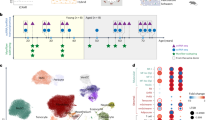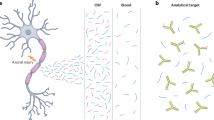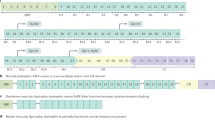Abstract
Duchenne muscular dystrophy (DMD) is a devastating progressive disease for which there is currently no effective treatment except palliative therapy. There are several promising genetic approaches, including viral delivery of the missing dystrophin gene, read-through of translation stop codons, exon skipping to restore the reading frame and increased expression of the compensatory utrophin gene. The lessons learned from these approaches will be applicable to many other disorders.
This is a preview of subscription content, access via your institution
Access options
Subscribe to this journal
Receive 12 print issues and online access
$189.00 per year
only $15.75 per issue
Buy this article
- Purchase on Springer Link
- Instant access to full article PDF
Prices may be subject to local taxes which are calculated during checkout


Similar content being viewed by others
References
Emery, A. E. H. Muscular Dystrophy (The Facts) (Oxford Univ. Press, 2008).
Cohn, R. D. & Campbell, K. P. Molecular basis of muscular dystrophies. Muscle Nerve 23, 1456–1471 (2000).
Aartsma-Rus, A. et al. Theoretic applicability of antisense-mediated exon skipping for Duchenne muscular dystrophy mutations. Hum. Mutat. 30, 293–299 (2009).
Fairclough, R. J., Perkins, K. J. & Davies, K. E. Pharmacologically targeting the primary defect and downstream pathology in Duchenne muscular dystrophy. Curr. Gene Ther. 12, 206–244 (2012).
Neri, M. et al. Dystrophin levels as low as 30% are sufficient to avoid muscular dystrophy in the human. Neuromuscul. Disord. 17, 913–918 (2007).
Cavazzana-Calvo, M. & Fischer, A. Gene therapy for severe combined immunodeficiency: are we there yet? J. Clin. Invest. 117, 1456–1465 (2007).
Vandenberghe, L. H. & Auricchio, A. Novel adeno-associated viral vectors for retinal gene therapy. Gene Ther. 19, 162–168 (2012).
Buchlis, G. et al. Factor IX expression in skeletal muscle of a severe hemophilia B patient 10 years after AAV-mediated gene transfer. Blood 119, 3038–3041 (2012).
Pichavant, C. et al. Current status of pharmaceutical and genetic therapeutic approaches to treat DMD. Mol. Ther. 19, 830–840 (2011).
Lai, Y. et al. Dystrophins carrying spectrin-like repeats 16 and 17 anchor nNOS to the sarcolemma and enhance exercise performance in a mouse model of muscular dystrophy. J. Clin. Invest. 119, 624–635 (2009).
Mendell, J. R. et al. Gene therapy for muscular dystrophy: lessons learned and path forward. Neurosci. Lett. 527, 90–99 (2012).
Mendell, J. R. et al. Sustained α-sarcoglycan gene expression after gene transfer in limb-girdle muscular dystrophy, type 2D. Ann. Neurol. 68, 629–638 (2010).
Mendell, J. R. et al. Dystrophin immunity in Duchenne's muscular dystrophy. N. Engl. J. Med. 363, 1429–1437 (2010).
Wang, Z. et al. Successful regional delivery and long-term expression of a dystrophin gene in canine muscular dystrophy: a preclinical model for human therapies. Mol. Ther. 20, 1501–1507 (2012).
Bidou, L., Allamand, V., Rousset, J. P. & Namy, O. Sense from nonsense: therapies for premature stop codon diseases. Trends Mol. Med. 18, 679–688 (2012).
Welch, E. M. et al. PTC124 targets genetic disorders caused by nonsense mutations. Nature 447, 87–91 (2007).
Finkel, R. S. Read-through strategies for suppression of nonsense mutations in Duchenne/Becker muscular dystrophy: aminoglycosides and ataluren (PTC124). J. Child Neurol. 25, 1158–1164 (2010).
McDonald, C. M. et al. The 6-minute walk test as a new outcome measure in Duchenne muscular dystrophy. Muscle Nerve 41, 500–510 (2010).
Kayali, R. et al. Read-through compound 13 restores dystrophin expression and improves muscle function in the mdx mouse model for Duchenne muscular dystrophy. Hum. Mol. Genet. 21, 4007–4020 (2012).
Bordeira-Carrico, R., Pego, A. P., Santos, M. & Oliveira, C. Cancer syndromes and therapy by stop-codon readthrough. Trends Mol. Med. 18, 667–678 (2012).
Muntoni, F. & Wood, M. J. Targeting RNA to treat neuromuscular disease. Nature Rev. Drug Discov. 10, 621–637 (2011).
Kinali, M. et al. Local restoration of dystrophin expression with the morpholino oligomer AVI-4658 in Duchenne muscular dystrophy: a single-blind, placebo-controlled, dose-escalation, proof-of-concept study. Lancet Neurol. 8, 918–928 (2009).
van Deutekom, J. C. et al. Local dystrophin restoration with antisense oligonucleotide PRO051. N. Engl. J. Med. 357, 2677–2686 (2007).
Cirak, S. et al. Exon skipping and dystrophin restoration in patients with Duchenne muscular dystrophy after systemic phosphorodiamidate morpholino oligomer treatment: an open-label, phase 2, dose-escalation study. Lancet 378, 595–605 (2011).
Goemans, N. M. et al. Systemic administration of PRO051 in Duchenne's muscular dystrophy. N. Engl. J. Med. 364, 1513–1522 (2011).
Betts, C. A., Hammond, S. M., Yin, H. F. & Wood, M. J. Optimizing tissue-specific antisense oligonucleotide-peptide conjugates. Methods Mol. Biol. 867, 415–435 (2012).
Mitrpant, C. et al. Rational design of antisense oligomers to induce dystrophin exon skipping. Mol. Ther. 17, 1418–1426 (2009).
Aoki, Y. et al. Bodywide skipping of exons 45–55 in dystrophic mdx52 mice by systemic antisense delivery. Proc. Natl Acad. Sci. USA 109, 13763–13768 (2012).
Cacchiarelli, D. et al. miRNAs as serum biomarkers for Duchenne muscular dystrophy. EMBO Mol. Med. 3, 258–265 (2011).
Roberts, T. C. et al. Expression analysis in multiple muscle groups and serum reveals complexity in the microRNA transcriptome of the mdxmouse with implications for therapy. Mol. Ther. Nucleic Acids 1, e39 (2012).
Nadarajah, V. D. et al. Serum matrix metalloproteinase-9 (MMP-9) as a biomarker for monitoring disease progression in Duchenne muscular dystrophy (DMD). Neuromuscul. Disord. 21, 569–578 (2011).
Zammarchi, F. et al. Antitumorigenic potential of STAT3 alternative splicing modulation. Proc. Natl Acad. Sci. USA 108, 17779–17784 (2011).
Khurana, T. S. & Davies, K. E. Pharmacological strategies for muscular dystrophy. Nature Rev. Drug Discov. 2, 379–390 (2003).
Miura, P. & Jasmin, B. J. Utrophin upregulation for treating Duchenne or Becker muscular dystrophy: how close are we? Trends Mol. Med. 12, 122–129 (2006).
Li, D. et al. Sarcolemmal nNOS anchoring reveals a qualitative difference between dystrophin and utrophin. J. Cell Sci. 123, 2008–2013 (2010).
Ramachandran, J. et al. Nitric oxide signaling pathway in Duchenne muscular dystrophy mice: upregulation of l-arginine transporters. Biochem. J. (2012).
Fisher, R. et al. Non-toxic ubiquitous over-expression of utrophin in the mdx mouse. Neuromuscul. Disord. 11, 713–721 (2001).
Kleopa, K. A., Drousiotou, A., Mavrikiou, E., Ormiston, A. & Kyriakides, T. Naturally occurring utrophin correlates with disease severity in Duchenne muscular dystrophy. Hum. Mol. Genet. 15, 1623–1628 (2006).
Sonnemann, K. J. et al. Functional substitution by TAT-utrophin in dystrophin-deficient mice. PLoS Med. 6, e1000083 (2009).
Chakkalakal, J. V., Miura, P., Belanger, G., Michel, R. N. & Jasmin, B. J. Modulation of utrophin A mRNA stability in fast versus slow muscles via an AU-rich element and calcineurin signaling. Nucleic Acids Res. 36, 826–838 (2008).
Moorwood, C., Soni, N., Patel, G., Wilton, S. D. & Khurana, T. S. A cell-based high-throughput screening assay for posttranscriptional utrophin upregulation. J. Biomol. Screen. 18, 400–406 (2012).
Tinsley, J. M. et al. Daily treatment with SMTC1100, a novel small molecule utrophin upregulator, dramatically reduces the dystrophic symptoms in the mdx mouse. PLoS ONE 6, e19189 (2011).
Amenta, A. R. et al. Biglycan recruits utrophin to the sarcolemma and counters dystrophic pathology in mdx mice. Proc. Natl Acad. Sci. USA 108, 762–767 (2011).
Angus, L. M. et al. Calcineurin-NFAT signaling, together with GABP and peroxisome PGC-1α, drives utrophin gene expression at the neuromuscular junction. Am. J. Physiol. Cell Physiol. 289, C908–C917 (2005).
Handschin, C. et al. PGC-1α regulates the neuromuscular junction program and ameliorates Duchenne muscular dystrophy. Genes Dev. 21, 770–783 (2007).
Tinsley, J. et al. Expression of full-length utrophin prevents muscular dystrophy in mdx mice. Nature Med. 4, 1441–1444 (1998).
van Putten, M. et al. Low dystrophin levels increase muscle survival and improve muscle pathology and function in dystrophin/utrophin double-knock-out mice. FASEB J. 4 Mar 2013 (10.1096/fj.12-224170).
Gambari, R. & Fibach, E. Medicinal chemistry of fetal hemoglobin inducers for treatment of β-thalassemia. Curr. Med. Chem. 14, 199–212 (2007).
Hirawat, S. et al. Safety, tolerability, and pharmacokinetics of PTC124, a nonaminoglycoside nonsense mutation suppressor, following single- and multiple-dose administration to healthy male and female adult volunteers. J. Clin. Pharmacol. 47, 430–444 (2007).
Heemskerk, H. A. et al. In vivo comparison of 2′-O-methyl phosphorothioate and morpholino antisense oligonucleotides for Duchenne muscular dystrophy exon skipping. J. Gene Med. 11, 257–266 (2009).
Acknowledgements
The authors are very grateful to the UK Medical Research Council, the Wellcome Trust, the UK Muscular Dystrophy Campaign, the US Muscular Dystrophy Association, Action Duchenne, the Association Française Contre les Myopathies and the International Consortium on Exon Skipping for support.
Author information
Authors and Affiliations
Corresponding author
Ethics declarations
Competing interests
Kay E. Davies is on the scientific advisory board of Prosensa plc and Summit plc. Rebecca J. Fairclough and Matthew J. Wood declare no competing financial interests.
Related links
Rights and permissions
About this article
Cite this article
Fairclough, R., Wood, M. & Davies, K. Therapy for Duchenne muscular dystrophy: renewed optimism from genetic approaches. Nat Rev Genet 14, 373–378 (2013). https://doi.org/10.1038/nrg3460
Published:
Issue Date:
DOI: https://doi.org/10.1038/nrg3460
This article is cited by
-
Pharmacological inhibition of HDAC6 improves muscle phenotypes in dystrophin-deficient mice by downregulating TGF-β via Smad3 acetylation
Nature Communications (2022)
-
Duchenne muscular dystrophy cell culture models created by CRISPR/Cas9 gene editing and their application in drug screening
Scientific Reports (2021)
-
MRTF-A regulates Ca2+ release through CACNA1S
Journal of Biosciences (2021)
-
The analysis of DMD gene deletions by multiplex PCR in Indonesian DMD/BMD patients: the era of personalized medicine
BMC Research Notes (2019)
-
Detection of collagens by multispectral optoacoustic tomography as an imaging biomarker for Duchenne muscular dystrophy
Nature Medicine (2019)



